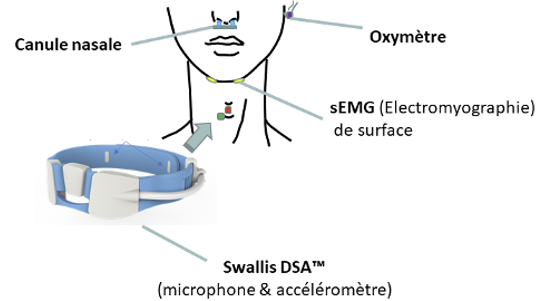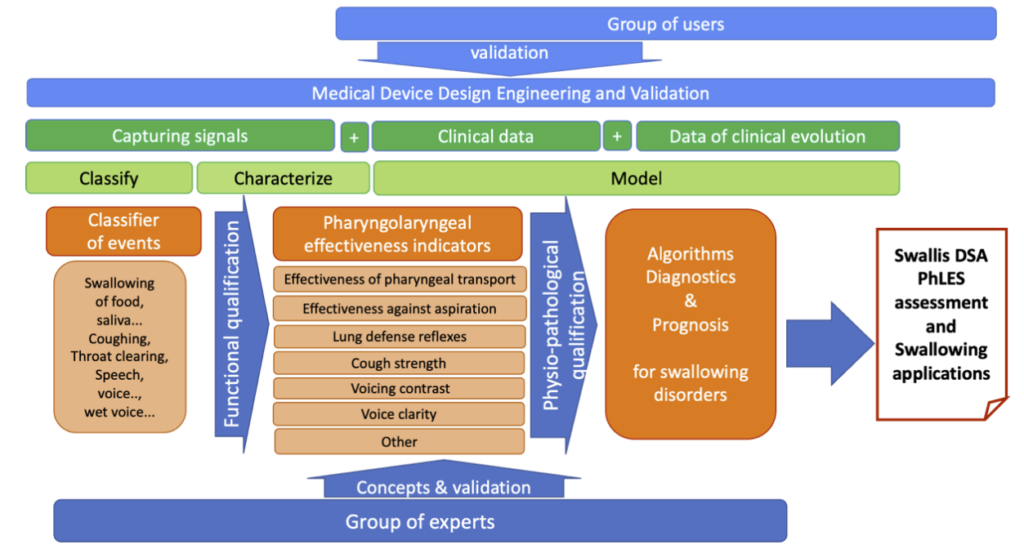PHLES-NID
Pharyngo-Laryngeal Effectiveness – Non Invasive Device

Context and objectives
Oropharyngeal dysphagia (OD) is a major public health problem. This swallowing disorder affects the elderly (50%) and patients with neurological disorders and head and neck cancer (80%), with the main complications being respiratory infections and undernutrition. These complications lead to long hospitalizations, the use of antibiotics and industrial modified food, and increased mortality rates in these already fragile populations. The control of these complications and the reduction of their consequences rely on the early detection and treatment of OD. However, at present, clinical explorations with low sensitivity, diagnostic imaging (video-fluoroscopy (VFS) and nasofibroscopy of swallowing (FEES)) considered invasive, time-consuming, not easily accessible, and moreover practiced by a limited number of specialists, make diagnosis and follow-up impossible for the vast majority of the population. In addition to these medical and technical limitations, there is a conceptual obstacle linked to the classical understanding of OD, which is exclusively evaluated through the efficiency of transport and protection mechanisms during food intake.
To address this public health problem, our PHLES-NID project will combine engineering sciences with new concepts. We will approach swallowing disorders in an exploratory and novel way with the concept of pharyngolaryngeal effectiveness (PhLEs). We will identify the indicators of the four pharyngolaryngeal functions (breathing, swallowing, airway protection, phonation) in relation to the swallowing mechanism. A specific heuristic on the fundamental role of pharyngo-laryngeal reflexes in airway protection will allow these indicators to predict the consequences of swallowing disorders.
Thus, our hypothesis is that a device associating several sensors able to detect different types of signals related to the pharyngolaryngeal functioning will allow, thanks to their processing by artificial intelligence, the early management of swallowing disorders and their follow-up.
The objectives of the project are:
- 1/ To model pharyngolaryngeal effectiveness indicators with reference to the main functions involving the pharyngolarynx: breathing, swallowing, airway protection mechanism and phonation,
- 2/ To model, by PhLEs indicators, the severity and prognosis of a swallowing disorder. Their measurements could then be integrated into the early management of patients predicting the risk of complications within 6 months.
The complementarity of the teams involved in this project and the articulation of the WPs will allow the conduct of the clinical study, the capture of signals, the analysis and the modeling of indicators.
At the end of the project, our team will have contributed to the validation of the concept of Pharyngolaryngeal effectiveness and will have developed an innovative medical device to be evaluated in a pathological context.

Collaborations
- Virginie Woisard (project leader), Sabine Crestani, Pascale Fichaux Bourin, Gaelle Soriano, Benoît Lepage, Clémence Devoucoux, Julie Milia, Anaïs Galtier (CHU Toulouse)
- Emanuelle Cugy, Solange Milhe de Saint Victor, Thomas Galice (CHU Bordeaux)
- Éric Verin, Armand Bonne, Rimeh Ayari (CHU Rouen)
- Sylvain Morinière, Franck Marmouset, Blandine Salami (CHU Tours)
- Linda Nicolini, Maxime Le Coz, Nicolas Perrin, Fabrice Neveu, (Swallis Medical)
- Muriel Lalain, Alain Ghio, Danielle Robert, Alexia Mattei (LPL Laboratoire Parole et Langage)
- Renée Speyer (UiO University of Oslo / Special Needs Education)
- Pierre Barel, Ines Sanchez (MiPih)
People involved in the SAMOVA team
- Jérôme Farinas ( IRIT scientific leader, team SAMOVA / SI department)
- Sandrine Mouysset (team APO/CISO deptartment)
- Philippe Allet (PhD student, team SAMOVA / SI department)
- Mathieu Balaguer
Funding
- Projet de Recherche Collaborative de l’Agence Nationale Recherche, Appel à Projet Générique 2021, section CE19 (Technologies pour la santé) ANR-21-CE19-0057
- 649 k€
Schedule
- Start time : 1st march 2022
- End time : 30th September 2026
